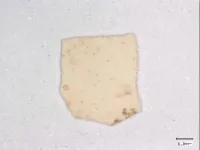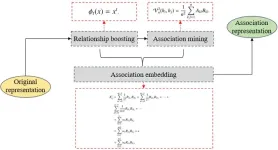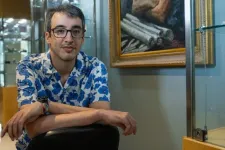(Press-News.org) Chickens are one of the most economically important animals in the world today. However, the story of their origins and dispersal across the ancient world is still poorly understood. In fact, new archaeological techniques have recently led to the recognition that many finds of bones previously thought to represent early chickens in fact belonged to wild birds. Now, in a new publication, an international team of archaeologists, historians, and biomolecular scientists present the earliest clear evidence for the raising of chickens for egg production, and argue that the loss of seasonal egg laying was the main driver for the dispersal of domestic chickens across Eurasia and northeast Africa.
Using eggshell fragments collected from 12 archaeological sites spanning roughly 1500 years, the researchers show that chickens were widely raised in Central Asia from approximately 400 BCE to 1000 CE and were likely dispersed along the ancient Silk Road. The abundance of eggshells further suggests that the birds were laying out of season. It was this trait of prolific egg laying, the researchers argue, that made the domestic chicken so attractive to ancient peoples.
To reach these conclusions, the team collected tens of thousands of eggshell fragments from sites located along the main Central Asian corridor of the Silk Road. They then used a method of biomolecular analysis called ZooMS to identify the source of the eggs. Much like genetic analysis, ZooMS can make species identifications from animal remains such as bone, skin and shell, but it relies on protein signals rather than DNA. This makes it a faster and more cost-effective option than genetic analysis.
“This study showcases the potential of ZooMS to shed light on human-animal interactions in the past,” says Dr. Carli Peters, researcher at the Max Planck Institute of Geoanthropology and first author of the new paper.
The identification of these shell fragments as chickens, and their abundance throughout the sediment layers at each site, led the researchers to an important conclusion: the birds must have been laying more frequently than their wild ancestor, the red jungle fowl, which nests once per year and typically lays six eggs per clutch.
“This is the earliest evidence for the loss of seasonal egg laying yet identified in the archaeological record,” says Dr. Robert Spengler, leader of the Domestication and Anthropogenic Evolution research group and principal investigator on the study. “This is an important clue for better understanding the mutualistic relationships between humans and animals that resulted in domestication.”
Taken together, the new study suggests an answer to the age-old riddle of the chicken and the egg. In Central Asia, evidence suggests that the ability to lay a multitude of eggs is what made the chicken the chicken we know today – a global species of enormous economic importance. The authors hope that this study will demonstrate the potential of new, cost-effective methods and interdisciplinary collaboration to address long-standing questions about the past.
END
When did the chicken cross the road? New evidence from Central Asia
New research reveals that chickens were widely raised across southern Central Asia from 400 BCE through medieval periods and likely dispersed along the ancient Silk Road
2024-04-02
ELSE PRESS RELEASES FROM THIS DATE:
A data representation method using distance correlation
2024-04-02
Association in-between features has been demonstrated to improve the representation ability of data. However, the original association data reconstruction method may face two issues: the dimension of reconstructed data is undoubtedly highly than that of original data, and adopted association measure method does not well balance effectiveness and efficiency.
To solve the problems, a research team led by Yuhua QIAN published their new research on 12 Mar 2024 in Frontiers of ...
Lundquist investigator Dr. Eiji Yoshihara awarded $3 million NIH R01 grant for diabetes stem cell therapy research
2024-04-02
The National Institute of Diabetes and Digestive and Kidney Diseases (NIDDK), a division of the National Institutes of Health, has granted Eiji Yoshihara, PhD, a principal investigator at The Lundquist Institute (TLI) and assistant professor at the David Geffen School of Medicine at UCLA, a five-year grant totaling $3 million. This prestigious NIH R01 grant, known for its rigorous peer-review process, is dedicated to advancing stem cell therapy research for treating diabetes.
Insulin-dependent diabetes, including autoimmune Type 1 and stress-induced Type 2, presents a significant health burden, often necessitating lifelong ...
YKT6 gene variants cause a new genetic disorder finds a new study
2024-04-02
A recent collaborative study has discovered rare variants in the YKT6 gene as the cause of a new neurological disorder characterized by developmental delays along with severe progressive liver disease and a potential risk for liver cancer. The study, published in Genetics in Medicine, was led by Dr. Hugo Bellen, Distinguished Service Professor at Baylor College of Medicine and Principal Investigator at the Jan and Dan Duncan Neurological Research Institute (Duncan NRI) at Texas Children’s Hospital, and Dr. Wendy Chung, the Chief of the Department of Pediatrics at Boston Children’s ...
Australia on track for unprecedented, decades-long megadroughts
2024-04-02
Australia could soon see megadroughts that last for more than 20 years, according to new modelling from The Australian National University (ANU) and the ARC Centre of Excellence for Climate Extremes.
The researchers’ bleak findings are before factoring in human impact on the climate since the Industrial Revolution. The ANU-led team also found that 20th century droughts in southwestern and eastern Australia, including the Murray-Darling Basin, were longer on average compared to pre-industrial times.
According to the scientists, the findings paint a worrying picture of future droughts in Australia that are far worse than anything in recent experience.
Megadroughts are exceptionally ...
Dilling named associate laboratory director for neutron sciences at ORNL
2024-04-02
Jens Dilling has been named associate laboratory director for the Neutron Sciences Directorate, or NScD, at the Department of Energy’s Oak Ridge National Laboratory, effective April 1.
“ORNL pioneered neutron scattering in the 1940s, developing a new technique that enables scientists to explore and create new materials, batteries and more,” ORNL Director Stephen Streiffer said. “Today, ORNL remains at the forefront of this science, and Jens will play a critical role in ensuring the nation's ...
UC San Diego receives $6.7M to develop whole-body inflammation imaging
2024-04-02
Researchers at University of California San Diego School of Medicine have been awarded two new grants by the National Institutes of Health (NIH), totaling $6.7 million, to develop and clinically test technologies that can noninvasively examine and quantify immune cells found in tumors. These immune cells, called macrophages, are involved in the body’s normal inflammatory responses, but they also make up a significant portion of solid tumors. The density of macrophages in a tumor can affect how it responds to treatment, so the ability to count them noninvasively could help doctors decide which therapies ...
Health care utilization is increased in high-risk children who have a sleep disorder
2024-04-01
DARIEN, IL – The risk of increased health care utilization among children with a chronic medical condition is higher for those who also have a sleep disorder, according to a new study that examined Medicaid claims data.
The study found that among children who had a chronic medical condition, those who also had a diagnosed sleep disorder were nearly two times more likely to have increased health care utilization (odds ratio = 1.83) than those who had no sleep disorder. The most common sleep disorder diagnosis was sleep-disordered breathing, which was present in 1,796 children. ...
More than 18,000 excess TB cases in the U.S. attributable to structural racism
2024-04-01
Embargoed for release until 5:00 p.m. ET on Monday 1 April 2024
Annals of Internal Medicine Tip Sheet
@Annalsofim
Below please find summaries of new articles that will be published in the next issue of Annals of Internal Medicine. The summaries are not intended to substitute for the full articles as a source of information. This information is under strict embargo and by taking it into possession, media representatives are committing to the terms of the embargo not only ...
Rice’s Mark Torres wins NSF CAREER Award to examine river water chemistry
2024-04-01
Mark Torres, assistant professor of Earth, environmental and planetary sciences at Rice University, has won a National Science Foundation (NSF) CAREER Award to unlock new insights in river water chemistry, including its implications for addressing environmental concerns.
Torres’ five-year, $612,930 grant is to develop innovative approaches for analyzing variations in river water chemistry. He will lead a research team to shed light on the interplay between water flow and chemical reactions to better understand the effects of climate change on water resources.
“The chemistry ...
Texas Tech researcher part of breakthrough findings
2024-04-01
For Tom Maccarone, the universe really is his laboratory.
“I am drawn to the idea of things going on where there are conditions you have little or no hope of reproducing in a lab,” said Maccarone, a professor in the Department of Physics and Astronomy at Texas Tech University. “It gives you a way to do the most exotic physics experiments without having to build a giant laboratory. I am also drawn to problems where we still don’t really know anything.”
Maccarone recently enjoyed the best of both ...
LAST 30 PRESS RELEASES:
Sea reptile’s tooth shows that mosasaurs could live in freshwater
Pure bred: New stem cell medium only has canine components
Largest study of its kind highlights benefits – and risks – of plant-based diets in children
Synergistic effects of single-crystal HfB2 nanorods: Simultaneous enhancement of mechanical properties and ablation resistance
Mysterious X-ray variability of the strongly magnetized neutron star NGC 7793 P13
The key to increasing patients’ advance care medical planning may be automatic patient outreach
Palaeontology: Ancient tooth suggests ocean predator could hunt in rivers
Polar bears may be adapting to survive warmer climates, says study
Canadian wildfire smoke worsened pediatric asthma in US Northeast: UVM study
New UBCO research challenges traditional teen suicide prevention models
Diversity language in US medical research agency grants declined 25% since 2024
Concern over growing use of AI chatbots to stave off loneliness
Biomedical authors often call a reference “recent” — even when it is decades old, analysis shows
The Lancet: New single dose oral treatment for gonorrhoea effectively combats drug-resistant infections, trial finds
Proton therapy shows survival benefit in Phase III trial for patients with head and neck cancers
Blood test reveals prognosis after cardiac arrest
UBCO study finds microdosing can temporarily improve mood, creativity
An ECOG-ACRIN imaging study solves a long-standing gap in metastatic breast cancer research and care: accurately measuring treatment response in patients with bone metastases
Cleveland Clinic presents final results of phase 1 clinical trial of preventive breast cancer vaccine study
Nationally renowned anesthesiology physician-scientist and clinical operations leader David Mintz, MD, PhD, named Chair of the Department of Anesthesiology at the UM School of Medicine
Clean water access improves child health in Mozambique, study shows
Study implicates enzyme in neurodegenerative conditions
Tufts professor named Fellow of the National Academy of Inventors
Tiny new device could enable giant future quantum computers
Tracing a path through photosynthesis to food security
First patient in Arizona treated with new immune-cell therapy at HonorHealth Research Institute
Studies investigate how AI can aid clinicians in analyzing medical images
Researchers pitch strategies to identify potential fraudulent participants in online qualitative research
Sweeping study shows similar genetic factors underlie multiple psychiatric disorders
How extreme weather events affect agricultural trade between US states
[Press-News.org] When did the chicken cross the road? New evidence from Central AsiaNew research reveals that chickens were widely raised across southern Central Asia from 400 BCE through medieval periods and likely dispersed along the ancient Silk Road





